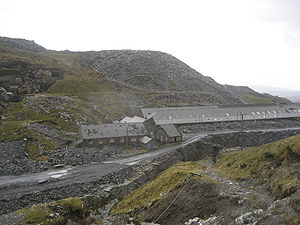- Maenofferen Quarry
-
 The abandoned Maenofferen slate cutting mill, seen from the Rhiwbach Tramway No. 3 incline, 2007
The abandoned Maenofferen slate cutting mill, seen from the Rhiwbach Tramway No. 3 incline, 2007
Maenofferen Quarry is a major slate quarry in the town of Blaenau Ffestiniog, north Wales and one of the major users of the Ffestiniog Railway. It continues to produce crushed slate on a limited scale under the ownership of the nearby Llechwedd quarry.
Contents
History
Maenofferen was first worked for slate by men from the nearby Diphwys quarry shortly after 1800. By 1848 slate was being shipped via the Ffestiniog Railway, but traffic on the railway ceased in 1850. In 1857 traffic resumed briefly and apart from a gap in 1865, a steady flow of slate was dispatched via the railway. The initial quarry on the site was known as the David Jones quarry which was the highest and most easterly of what became the extensive Maenofferen complex.
In 1861 the Maenofferen Slate Quarry Co. Ltd. was incorporated, producing around 400 tons of slate that year. The company leased a wharf at Porthmadog in 1862 and shipped 181 tons of finished slate over the Ffestiniog Railway the following year.
During the nineteenth century the quarry flourished and expanded, extending its workings underground and further downhill towards Blaenau Ffestiniog. By 1897 it employed 429 people with almost half of those working underground. The Ffestiniog Railway remained the quarry's major transport outlet for its products, but there was no direct connection from it to the Ffestiniog's terminus at Duffws. Instead slate was sent via the Rhiwbach Tramway which ran through the quarry. This incurred extra shipping costs that rival quarries did not have to bear.
In 1908 the company leased wharf space at Minffordd, installing turntables and siding to allow finished slates to be transshipped to the standard gauge railway there.
In 1920 the company solved its high shipping costs by building a new incline connecting its mill to the Votty & Bowydd quarry and reaching agreement to ship its products via that company's incline connection to the Ffestiniog Railway at Duffws.
In 1928 Maeofferen purchased the Rhiwbach quarry, continuing to work it and use its associated Tramway until 1953.
When the Ffestiniog Railway ceased operation in 1946, Maeofferen leased a short length of the railway's tracks between Duffws station and the interchange with the LMS railway, west of Blaenau Ffestiniog. Slate trains continued to run over this section until 1962, Maenofferen then becoming the last slate quarry to use any part of the Ffestiniog Railway's route. From 1962 slate was shipped from the quarry by road, although the internal quarry tramways including stretches of the Rhiwbach tramway continued in use until at least the 1980s.
The quarry was purchased by the nearby Llechwedd quarry in 1975 together with Bowydd, which also incorporated the old Votty workings: these are owned by the Maenofferen Company. Underground production at Maenofferen ceased during November 1999 and with it the end of large-scale underground working for slate in north Wales. Production of slate recommenced on the combined Maenofferen site, consisting of "untopping" underground workings to recover slate from the supporting pillars of the chambers. Material recovered from the quarry tips will also be recovered for crushing and subsequent use.
Locomotives
Name Type Builder Date Works number Notes Sanford 0-4-0 ST W. G. Bagnall 1900 1571 Sold to the Penrhyn Quarry in 1929, subsequently scrapped Skinner 0-4-0 ST W.G. Bagnall 1906 1766 Sold to Penrhyn Quarry in 1929 4wPM Rhiwbach Tramway ex Rhiwbach Tramway 4wPE Motor Rail 4wPM Rhiwbach Tramway after 1946 Built by Muirhill; used for shunting between Duffws and LMS exchange station. Scrapped 1966. 4wPM Hibberd 1821 Scrapped 1966 4wPM Hibberd 1929 Scrapped 1956 References
- Boyd, James I.C. (1975). The Festiniog Railway: Volume 2. The Oakwood Press.
External links
- AditNow - Photographic database of Maenofferen Slate Mine
- Rhiwbach Tramway - Photo journal of a trip into the quarry in 2007
Ffestiniog Railway Stations Porthmadog Harbour • Boston Lodge Halt • Minffordd • Penrhyn • Rhiw Goch • Plas Halt • Tan-y-Bwlch • Campbell's Platform • Dduallt • Tanygrisiau • Blaenau Ffestiniog
Other Locations Quarries Blaen y Cwm Quarry • Cwt y Bugail Quarry • Llechwedd quarry • Maenofferen Quarry • Oakeley Quarry
People Rolling stock Related railways Categories:- Slate mines in Gwynedd
- Ffestiniog Railway
Wikimedia Foundation. 2010.

